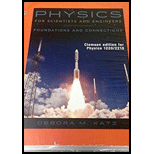
Concept explainers
(a)
The amount of heat that need to flow into Zan to completely melt his body.
(a)
Answer to Problem 84PQ
The amount of heat that need to flow into Zan to completely melt his body is
Explanation of Solution
Zan is initially existing as ice at temperature
In order Zan to completely melt his body, first the
Write the expression for the heat corresponding to temperature change.
Here,
Write the expression for the heat required for phase transition from solid to liquid.
Here,
Write the expression for the total heat absorbed by the body in the process.
Conclusion:
Substitute
Substitute
Substitute
Therefore, the amount of heat that need to flow into Zan to completely melt his body is
(b)
The amount of additional heat required to make the water form of Zan’s body to become vapor at
(b)
Answer to Problem 84PQ
The amount of additional heat required to make the water form of Zan’s body to start vaporizing at
Explanation of Solution
Initial temperature of water is
Write the expression for the heat corresponding to the temperature change.
Conclusion:
Substitute
Therefore, the amount of additional heat required to make the water form of Zan’s body to start vaporizing at
(c)
The amount of additional heat required to make the
(c)
Answer to Problem 84PQ
The amount of additional heat required to make the
Explanation of Solution
The mass of water is
Write the expression for the heat corresponding to the phase transition from liquid to vapor.
Here,
Conclusion:
Substitute
Therefore, the amount of additional heat required to make the
(d)
The average kinetic energy of one of water vapor molecule that make up Zan.
(d)
Answer to Problem 84PQ
The average kinetic energy of one of water vapor molecule that make up Zan is
Explanation of Solution
The temperature of the water vapor is
Write the expression for the average kinetic energy of one molecule of water vapor.
Here,
Conclusion:
Substitute
Therefore, the average kinetic energy of one of water vapor molecule that make up Zan is
Want to see more full solutions like this?
Chapter 21 Solutions
Physics for Scientists and Engineers: Foundations and Connections
- (Figure 1)In each case let w be the weight of the suspended crate full of priceless art objects. The strut is uniform and also has weight w Find the direction of the force exerted on the strut by the pivot in the arrangement (a). Express your answer in degrees. Find the tension Tb in the cable in the arrangement (b). Express your answer in terms of w. Find the magnitude of the force exerted on the strut by the pivot in the arrangement (b). Express your answer in terms of w.arrow_forward(Figure 1)In each case let ww be the weight of the suspended crate full of priceless art objects. The strut is uniform and also has weight w. Find the direction of the force exerted on the strut by the pivot in the arrangement (b). Express your answer in degrees.arrow_forwardA 70.0 cm, uniform, 40.0 N shelf is supported horizontally by two vertical wires attached to the sloping ceiling (Figure 1). A very small 20.0 N tool is placed on the shelf midway between the points where the wires are attached to it. Find the tension in the left-hand wire. Express your answer with the appropriate units.arrow_forward
- Find the total bind Mev. binding energy for 13 Carbon, 6C (atomic mass = 13.0033554)arrow_forwardWhat is the 27 energy absorbed in this endothermic Auclear reaction 2] Al + 'n → 27 Mg + ! H? (The atom mass of "Al is 26.981539u. and that of 11 Mg is 26.984341u) MeVarrow_forwardWhat is the energy released in this nuclear reaction 1 F + "', H-1 O+ He? 19 19 16 (The atomic mass of 1F is 18.998403 u, and that of 20 is 15.9949154) MeV.arrow_forward
- What is the energy released in this B+ nuclear reaction خالد 2½ Al w/ Mg + ie? (The atomic mass of 11 Al is 23.9999394 and that > of 12 Mg is 23.985041 u) MeV.arrow_forwardWhat is the energy released / absorbed in this nuclear reaction 14 N+ & He → » O + ! N? (The atomic mass of 14 N is 14.003074u. 17N+ and that of 10 is 16.9991324). MeVarrow_forwardCan someone help me answer this question thanks.arrow_forward
- Can someone help me with this question thanks.arrow_forward4B. Four electrons are located on the corners of a square, one on each corner, with the sides of the square being 25 cm long. a) Draw a sketch of the scenario and use your sketch to b) Determine the total force (magnitude and direction) on one of the electrons from the other three?arrow_forwardPortfolio Problem 3. A ball is thrown vertically upwards with a speed vo from the floor of a room of height h. It hits the ceiling and then returns to the floor, from which it rebounds, managing just to hit the ceiling a second time. Assume that the coefficient of restitution between the ball and the floor, e, is equal to that between the ball and the ceiling. Compute e.arrow_forward
 Physics for Scientists and Engineers: Foundations...PhysicsISBN:9781133939146Author:Katz, Debora M.Publisher:Cengage Learning
Physics for Scientists and Engineers: Foundations...PhysicsISBN:9781133939146Author:Katz, Debora M.Publisher:Cengage Learning Principles of Physics: A Calculus-Based TextPhysicsISBN:9781133104261Author:Raymond A. Serway, John W. JewettPublisher:Cengage Learning
Principles of Physics: A Calculus-Based TextPhysicsISBN:9781133104261Author:Raymond A. Serway, John W. JewettPublisher:Cengage Learning College PhysicsPhysicsISBN:9781938168000Author:Paul Peter Urone, Roger HinrichsPublisher:OpenStax College
College PhysicsPhysicsISBN:9781938168000Author:Paul Peter Urone, Roger HinrichsPublisher:OpenStax College An Introduction to Physical SciencePhysicsISBN:9781305079137Author:James Shipman, Jerry D. Wilson, Charles A. Higgins, Omar TorresPublisher:Cengage Learning
An Introduction to Physical SciencePhysicsISBN:9781305079137Author:James Shipman, Jerry D. Wilson, Charles A. Higgins, Omar TorresPublisher:Cengage Learning
 Physics for Scientists and Engineers, Technology ...PhysicsISBN:9781305116399Author:Raymond A. Serway, John W. JewettPublisher:Cengage Learning
Physics for Scientists and Engineers, Technology ...PhysicsISBN:9781305116399Author:Raymond A. Serway, John W. JewettPublisher:Cengage Learning





